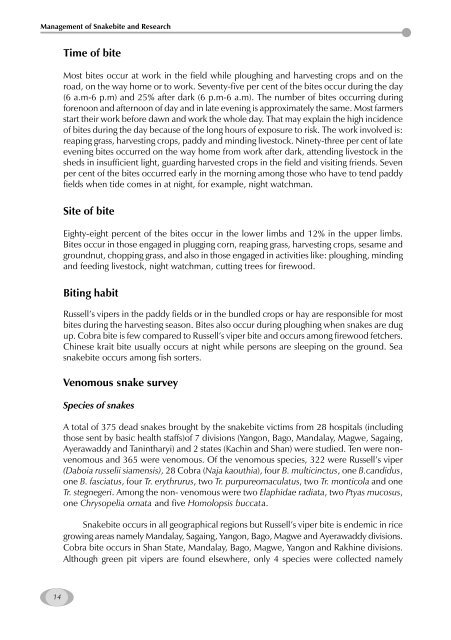Management of Snakebite and Research Management of Snakebite ...
Management of Snakebite and Research Management of Snakebite ...
Management of Snakebite and Research Management of Snakebite ...
You also want an ePaper? Increase the reach of your titles
YUMPU automatically turns print PDFs into web optimized ePapers that Google loves.
<strong>Management</strong> <strong>of</strong> <strong>Snakebite</strong> <strong>and</strong> <strong>Research</strong><br />
14<br />
Time <strong>of</strong> bite<br />
Most bites occur at work in the field while ploughing <strong>and</strong> harvesting crops <strong>and</strong> on the<br />
road, on the way home or to work. Seventy-five per cent <strong>of</strong> the bites occur during the day<br />
(6 a.m-6 p.m) <strong>and</strong> 25% after dark (6 p.m-6 a.m). The number <strong>of</strong> bites occurring during<br />
forenoon <strong>and</strong> afternoon <strong>of</strong> day <strong>and</strong> in late evening is approximately the same. Most farmers<br />
start their work before dawn <strong>and</strong> work the whole day. That may explain the high incidence<br />
<strong>of</strong> bites during the day because <strong>of</strong> the long hours <strong>of</strong> exposure to risk. The work involved is:<br />
reaping grass, harvesting crops, paddy <strong>and</strong> minding livestock. Ninety-three per cent <strong>of</strong> late<br />
evening bites occurred on the way home from work after dark, attending livestock in the<br />
sheds in insufficient light, guarding harvested crops in the field <strong>and</strong> visiting friends. Seven<br />
per cent <strong>of</strong> the bites occurred early in the morning among those who have to tend paddy<br />
fields when tide comes in at night, for example, night watchman.<br />
Site <strong>of</strong> bite<br />
Eighty-eight percent <strong>of</strong> the bites occur in the lower limbs <strong>and</strong> 12% in the upper limbs.<br />
Bites occur in those engaged in plugging corn, reaping grass, harvesting crops, sesame <strong>and</strong><br />
groundnut, chopping grass, <strong>and</strong> also in those engaged in activities like: ploughing, minding<br />
<strong>and</strong> feeding livestock, night watchman, cutting trees for firewood.<br />
Biting habit<br />
Russell’s vipers in the paddy fields or in the bundled crops or hay are responsible for most<br />
bites during the harvesting season. Bites also occur during ploughing when snakes are dug<br />
up. Cobra bite is few compared to Russell’s viper bite <strong>and</strong> occurs among firewood fetchers.<br />
Chinese krait bite usually occurs at night while persons are sleeping on the ground. Sea<br />
snakebite occurs among fish sorters.<br />
Venomous snake survey<br />
Species <strong>of</strong> snakes<br />
A total <strong>of</strong> 375 dead snakes brought by the snakebite victims from 28 hospitals (including<br />
those sent by basic health staffs)<strong>of</strong> 7 divisions (Yangon, Bago, M<strong>and</strong>alay, Magwe, Sagaing,<br />
Ayerawaddy <strong>and</strong> Tanintharyi) <strong>and</strong> 2 states (Kachin <strong>and</strong> Shan) were studied. Ten were nonvenomous<br />
<strong>and</strong> 365 were venomous. Of the venomous species, 322 were Russell’s viper<br />
(Daboia russelii siamensis), 28 Cobra (Naja kaouthia), four B. multicinctus, one B.c<strong>and</strong>idus,<br />
one B. fasciatus, four Tr. erythrurus, two Tr. purpureomaculatus, two Tr. monticola <strong>and</strong> one<br />
Tr. stegnegeri. Among the non- venomous were two Elaphidae radiata, two Ptyas mucosus,<br />
one Chrysopelia ornata <strong>and</strong> five Homolopsis buccata.<br />
<strong>Snakebite</strong> occurs in all geographical regions but Russell’s viper bite is endemic in rice<br />
growing areas namely M<strong>and</strong>alay, Sagaing, Yangon, Bago, Magwe <strong>and</strong> Ayerawaddy divisions.<br />
Cobra bite occurs in Shan State, M<strong>and</strong>alay, Bago, Magwe, Yangon <strong>and</strong> Rakhine divisions.<br />
Although green pit vipers are found elsewhere, only 4 species were collected namely









